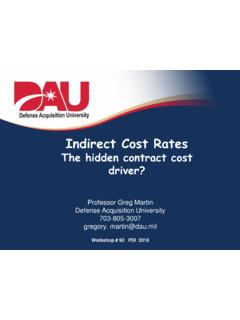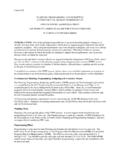Transcription of Cost-Benefit Analysis - PDI 2016
1 Cost-Benefit Analysis Rick Hurley 2 June 2016. PDI Orlando, FL. Definition of Cost-Benefit Analysis (CBA). A structured methodology of forecasting and comparing the anticipated costs and benefits of alternative courses of action in order to identify the most effective manner of achieving a stated goal or objective Purposes of CBA. 1. To determine if a policy or investment decision is feasible ( , do the associated net benefits exceed the associated net costs of a policy or investment decision?). 2. To provide a basis for comparing projects. It involves comparing the total expected cost of each option against the total expected benefits to see whether the benefits outweigh the costs and by how much.
2 Source: Army CBA Guide and OMB A-94. Characteristics of Cost-Benefit Analysis Decision support tool (informs, but does not decide). Predicts effects of actions under consideration for: Addressing a problem or challenge Pursuing an opportunity Quantifies financial impacts and business benefits ( , cost savings, performance improvements). Considers nonfinancial and nonquantifiable impacts Includes risk Analysis Focus is to find the optimal solution Supports decision making, not end all . WHY CBA? Key Reasons for CBA. Resource constraints increase focus on stewardship of dollars CBA strengthens ability to properly manage requirement and resourcing processes Key to providing accurate and complete information to decision makers SECDEF mandates use of CE/CBA to support resource-informed decision making Army CBA Memo Department of Army has directed that all unfunded requirements and new or expanded program proposals be accompanied by a thorough Cost-Benefit Analysis Undersecretary of the Army and the Vice Chief of Staff of the Army DOD CBA Memo Secretary of Defense Key Principles and Concepts Terminology CBA, BCA, EA, cost -effectiveness Analysis Net present value (NPV)
3 And related outcome measures Elements of CBA. Policy rationale or problem statement Explicit assumptions Evaluation of alternatives Who does and when? Eight-step model Key Federal Sources for CBA Guidelines OMB Circular A-94. GAO cost Estimating and Assessment Guide (GAO-09-3SP). Army Cost-Benefit Analysis Guide AF Manual on Economic Analysis OMB Circular A-11, Supplement to Part 7: Capital Programming Guide CBA 8-Step Process 1. Define the problem/opportunity Step 1. 2. Define scope; formulate facts and assumptions 3. Define alternatives 4. Develop cost estimate for alternatives under consideration Define the 5. Identify quantifiable and nonquantifiable benefits Problem/.
4 Opportunity 6. Define alternative selection criteria 7. Compare alternatives 8. Report results and recommendations Step 1: Define the Problem/Opportunity; Describe the Background Define the initiative or proposal using a problem or opportunity statement Define the objective/goal Capture the voice of the stakeholder (the customer) and decision criteria Describe the background and circumstances Opportunity Statement Key state problem or opportunity in terms of the organization's mission that requires a solution to describe what the effort intends to accomplish. What required performance or outcome is not being achieved? What is the perceived capability gap or improvement in question?
5 Who and what are impacted by this problem? Opportunity Statement Examples The common access card (CAC) issuing process needs to be improved. We've received numerous complaints from DoD civilians and soldiers.. The CAC card processing office needs an increase of $1M per year to support seven additional employees.. Opportunity Statement Examples (continued). The CAC process at X base has shown a steady increase in lead time from 2 hours to hours since January 2010 due to changes in policy, organizational changes, and total number of CAC transactions. This Analysis presents costs and benefits of the potential solutions in addressing this issue.. Objective/Goal Whenever possible, objectives should be SMART: Specific Measurable Achievable Realistic Time-bound Possible Objective Measures Reduce number of man hours of effort required for a mission by a minimum of X%.
6 Increase output produced by the organization by no less than X units per month Improve product quality by committing less errors per page Provide a new or increased level of service at a reasonable cost Background Background and circumstances define and assess the current state/condition Provides the contextual information needed to fully understand the problem, need, or opportunity to be addressed in the CBA. Questions for Step 1. Do the problem statement and scope define a clear, unambiguous issue? Are the objectives consistent with other organizational objectives? Is the requirement temporary or permanent? Has the Voice of the Stakeholder been gathered? They best define the problem, on the front lines.
7 How and what other major stakeholders are likely to be impacted? Is the requirement part of a larger program or strategy? Step 2. 1. Define the problem/opportunity 2. Define scope; formulate facts and assumptions 3. Define alternatives 4. Develop cost estimate for alternatives under consideration Define Scope;. 5. Identify quantifiable and nonquantifiable benefits Formulate Facts 6. Define alternative selection criteria and Assumptions 7. Compare alternatives 8. Report results and recommendations Step 2: Define Scope; Formulate Facts and Assumptions Assumptions identify conditions that are essential to the success of the solution and involve degree of uncertainty Facts empirically true supported by evidence Can include constraints or limits placed on resources for the project Constraint considerations could include technical, environmental, political, time, dollars, etc.
8 Questions for Step 2. Scope considerations clearly defined Were the assumptions developed by an appropriate subject matter expert and agreed upon? Are the assumptions clearly stated, fully documented, and realistic? Are all relevant constraints identified? Are the assumptions and constraints structured in a manner that is clearly intended to favor one COA? If needed, are assumptions concerning information Important Note Results of Step 1 and Step 2 are validated with the proper leadership before other steps are undertaken! 1. Define the problem/opportunity 2. Define scope; formulate facts and assumptions Step 3. 3. Define alternatives 4. Develop cost estimate for alternatives under consideration 5.
9 Identify quantifiable and nonquantifiable benefits Define 6. Define alternative selection criteria Alternatives 7. Compare alternatives 8. Report results and recommendations Step 3: Define Alternatives Define the status quo The status quo baseline Documenting the status quo Define alternative COAs Screen for suitability, feasibility, cost /value/risk balance consideration, completeness, distinguishable (from other COAs). Consider eliminating if unacceptable cost /performance, non- conformance with schedule, political and environmental concerns, unrealistic dependence on assumptions Document, document! Identify the second and third order effects Questions for Step 3: Define Alternatives Have all feasible alternatives been considered?
10 Are all alternatives presented feasible? Are all relevant costs and benefits included in the baseline and alternatives? Are the costs and benefits of the status quo and alternatives detailed/documented to support relevant Analysis ? Have we identified and coordinated with all appropriate parties/stakeholders as appropriate? 1. Define the problem/opportunity Step 4. 2. Define scope; formulate facts and assumptions 3. Define alternatives Develop cost 4. Develop cost estimate for alternatives under consideration Estimate for 5. Identify quantifiable and nonquantifiable benefits Alternatives Under 6. Define alternative selection criteria Consideration 7. Compare alternatives 8.









